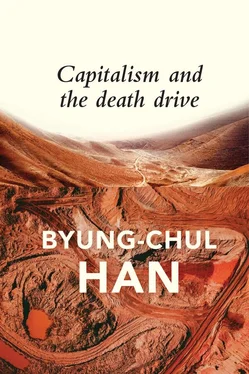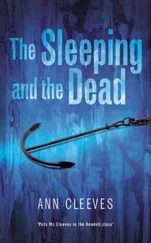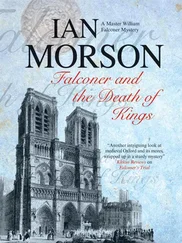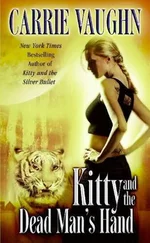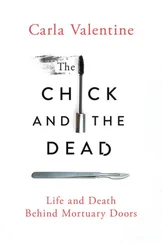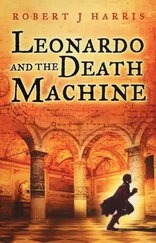The death drive inherent in every living being, the urge to return to the inanimate state, does not explain the decidedly narcissistic enjoyment that the ego takes in sadistic violence. In order to account for sadism, there must be an altogether different kind of destructive drive.
According to Maris, the driving force of capitalism is a death drive that serves the purposes of growth. But this does not tell us what brings about the irrational compulsion of growth itself: the compulsion that makes capitalism so destructive. What is it that forces capitalism blindly to pursue accumulation? At this point, death enters the frame. Capitalism rests on a negation of death. Capital is accumulated as a defence against death, against absolute loss. Death is what accounts for the compulsion of production and growth. Maris scarcely pays attention to death. Even Freud does not address death as such. The idea of the death drive, as a death wish, conceals the fear of death. Tellingly, Freud does not take into account the fact that every living being resists death. He remarks, somewhat oddly, that the idea of the death drive means ‘[w]e have no longer to reckon with the organism’s puzzling determination (so hard to fit into any context) to maintain its own existence in the face of every obstacle’. 12It is therefore not unreasonable to suggest that Freud’s idea of a death drive ultimately represents an unconscious strategy for repressing the fact of death. 13
The specifically human form of aggression, violence , is closely connected to the awareness of death, which is exclusively human. The economy of violence is ruled by a logic of accumulation. The more violence you exert, the more powerful you feel. Accumulated killing power [ Tötungsgewalt ] produces a feeling of growth, force, power [ Macht ] – of invulnerability and immortality. The narcissistic enjoyment human beings take in sadistic violence is based on just this increase in power. Killing protects against death. By killing, you arrest death. An increase in killing power means a reduction in death. The nuclear arms race also mirrors this capitalist economy of violence. Accumulating killing capacity is imagined as a way of accumulating a survival capacity.
The archaic economy of violence is exhibited in the spiralling violence of the blood feud. In archaic societies, every death is interpreted as the effect of a violent cause. Thus, even a ‘natural’ death may lead to revenge. The violence that led to the death is met with counter-violence. Every death weakens the group. Thus, the group must kill in turn in order to restore its feeling of power. Blood revenge is not an act of retribution, not a punishment. It is not a case of a perpetrator being held to account. Punishment is a rationalization of revenge; it stops revenge from escalating. Unlike punishment, blood revenge is undirected. That is the very reason it is so devastating. Sometimes, a group determined to avenge a death will kill individuals who were not involved in the death at all. Achilles took revenge for the death of his friend Patroclus by killing, and ordering killing, randomly. Not only enemies but also vast numbers of animals were slaughtered.
The etymology of ‘money’ points towards a connection with sacrifice and cultural rites. Money was originally the medium of exchange used for buying sacrificial animals. Those with a lot of money acquired a divine power to kill: ‘Looked at from the perspective of its roots in sacrificial cults, money is as it were frozen sacrificial blood. To throw money around, to let it flow and watch it flow, produces an effect similar to the flow of blood in fights or on sacrificial altars.’ 14The hoarded money gives its owner the status of a predator. It immunizes him against death. At the level of depth psychology, this archaic belief continues to operate in the idea that accumulated killing capacity, and accumulated capital assets, will ward off death. Capital’s logic of accumulation corresponds exactly to the archaic economy of violence. Capital behaves like a modern version of mana. Mana is the name of that powerful, mysterious substance that one acquires through the act of killing. One accumulates it in order to create a feeling of power and invulnerability:
The warrior was thought to embody the mana of all those whom he had killed . . . The mana of the warrior’s spear was likewise increased with each death he inflicted. . . .; with a view to absorbing directly his mana, he ate some of his flesh; and to bind the presence of the empowering influence in battle . . . he wore as a part of his war dress some physical relic of his vanquished foe – a bone, a dried hand, sometimes a whole skull. 15
The accumulation of capital produces the same affect as the accumulation of mana. Growing capital means growing power. More capital means less death. Capital is accumulated in order to escape death. Capital may also be seen as frozen time; infinite amounts of capital create the illusion of an infinite amount of time. Time is money: confronted with a time-limited life, we accumulate time-as-capital.
Adalbert von Chamisso’s novella Peter Schlemihls wundersame Geschichte [ The Wonderful History of Peter Schlemihl ] can be read as an allegory of the capitalist economy. Schlemihl sells his shadow to the devil in return for a bottomless bag of gold (that is, infinite capital). The pact with the devil turns out to be a pact with capitalism. Infinite capital makes the shadow – which stands for the body and death – disappear. But Schlemihl soon realizes that a life without a shadow is impossible. He walks the earth as the undead. The moral is: death is a part of life. The story thus ends with this admonition: ‘But you, my friend, if you want to live among mankind, learn to revere first your shadow, and then your money.’ 16
Capitalism is obsessed with death. The unconscious fear of death is what spurs it on. The threat of death is what stirs its compulsion of accumulation and growth. This compulsion drives us towards not only ecological but also mental catastrophe. The destructive compulsion to perform combines self-affirmation and self-destruction in one. We optimize ourselves to death. Relentless self-exploitation leads to mental collapse. Brutal competition ends in destruction. It produces an emotional coldness and indifference towards others as well as towards one’s own self.
In capitalist societies, the dead and the dying are less and less visible. But death cannot simply be made to disappear. If, for instance, factories no longer exist, then work takes place everywhere. If mental asylums disappear, then madness has become normal. It is the same with death. If the dead are not visible, a rigor mortis has extended over all of life. Life freezes into survival: ‘In survival, death is repressed; life itself . . . would be nothing more than a survival determined by death.’ 17
The separation of life and death that is constitutive of the capitalist economy creates an undead life, death-in-life . Capitalism generates a paradoxical death drive; it deprives life of life. 18A life without death, which is what capitalism strives to achieve, is what is truly deadly. Performance zombies, fitness zombies, and Botox zombies: these are manifestations of undead life. The undead lack any vitality. Only life that incorporates death is truly alive. The mania for health is the biopolitical manifestation of capital itself .
Capitalism’s striving for life without death creates the necropolis – an antiseptic space of death, cleansed of human sounds and smells. Life processes are transformed into mechanical processes. The total adaptation of human life to mere functionality is already a culture of death. As a consequence of the performance principle, the human being ever more closely approximates a machine, and becomes alienated from itself. Dataism and artificial intelligence reify thinking. Thinking becomes calculating. Living memories are replaced with machine memories. Only the dead remember everything. Server farms are places of death. We bury ourselves alive in order to survive. In the hope of survival, we accumulate dead value, capital. The living world is being destroyed by dead capital. This is the death drive of capital. Capitalism is ruled by a necrophilia that turns living beings into lifeless things. A fateful dialectic of survival turns the living into the dead: the undead. Erich Fromm writes the following about a world ruled by necrophilia:
Читать дальше
